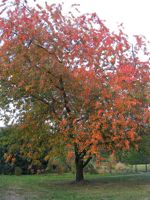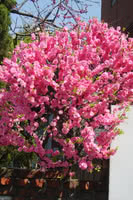Mon-Fri 9am - 5pm Mountain time
Black Cherry vs Double Flowering Plum
Prunus serotina
Prunus triloba Multiplex
NOT AVAILABLE THIS SEASON - MIGHT RETURN
NOT AVAILABLE THIS SEASON - MIGHT RETURN
Black Cherry is common in eastern North America but a rare find elsewhere. This tree is shade tolerant and is often found in old fields, forest openings, and along fencerows.
The fruit is edible and is commonly used to flavor rum and brandy. It is also edible and often eaten fresh or used in wine or jelly. Black Cherry trees typically begin producing fruit when they are 10 years of age.
Black Cherry wood is a rich reddish-brown color and is strong, making it valued in cabinetry and woodworking. It is often used in reclamation as well.
The leaves can poison livestock as they contain cyanide derivatives and precursors. However, many have noted that deer still seem to browse their trees with impunity and birds and other animals eat the fruit when available.
With the Double Flowering Plum in your garden, you'll be the envy of your block. Not only is it a stunning visual, but it is one of the earliest spring bloomers. With its gorgeous double pink blooms, this Plum is irresistible to birds, butterflies, and neighbours alike.
Black Cherry Quick Facts
Double Flowering Plum Quick Facts
Toxicity: bark and wilted leaves toxic to livestock

